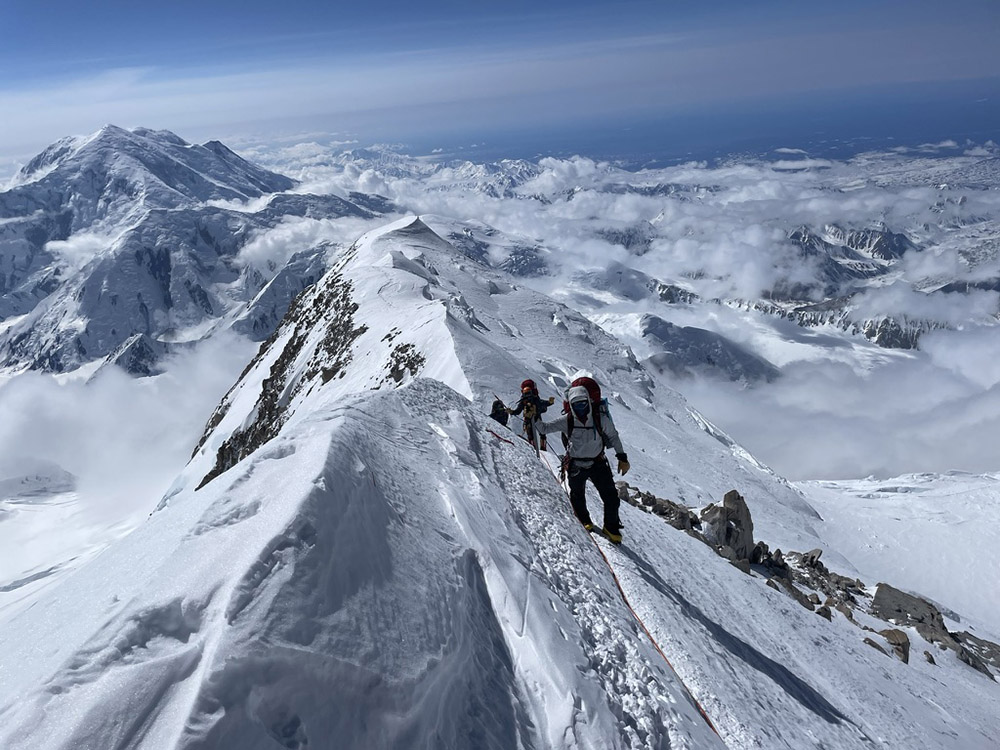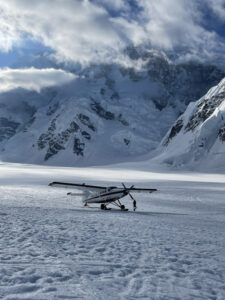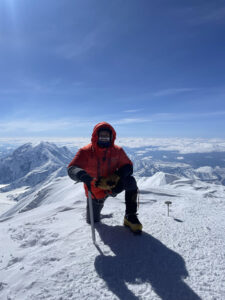How the CEO and AI pioneer Rene Morkos realized his dream of climbing Denali
Sitting in his tent at 11,000 feet on the West Buttress of Denali (20,310 feet), Rene Morkos wondered if all his months of preparation and training had suddenly stopped working.
It was June 2022, and Morkos, 40, the CEO of ALICE Technologies—a company that uses artificial intelligence to simulate construction projects—was sick. He’d begun to feel off the day before, feverish and achy. He realized he was likely coming down with a virus, what turned out to be a stomach bug. Morkos spent that night sweaty, clammy, tossing and turning in his sleeping bag. But he shrugged it off, waking up the next morning to do a load carry/acclimatization run to 13,500 feet, his pack laden with 40 pounds of equipment.
As he trudged up the steep slopes of the Alaskan giant, Morkos began to crater. “My body was going into anaerobic threshold [on the final 20 minutes], and there was that sting that you feel,” he says. “I started having these flashes in front of my eyes; my skin pulsed with this shock of the body saying, ‘I don’t want to do this!’” Up at 13,500 feet at the cache site just beyond Windy Corner, Morkos sat down in the snow and thought, This is not normal.
“The weather was great,” he says. “I was just miserable.”
He descended back to camp at 11,000 feet and that evening texted his Uphill Athlete coach John Frieh, with whom he’d been working for six months specifically to prepare for Denali. Recalls Morkos, “I was like, ‘Hey, I don’t know what’s up. I think your training just evaporated.’” Frieh, however, reminded Morkos that he’d tapered correctly and that six months of training was not simply going to disappear in two weeks. “Relax,” Frieh texted back. “I’m confident in my work; just stick to it. Once you acclimate and get over this bug, you’re going to power through.”
Says Morkos, “Getting that text from [John] was worth its weight in gold.”

Rene Morkos is one of the leading figures in artificial intelligence, a self-described “nerdy type” who had no athletic background as a child. Half Czech and half Lebanese, he grew up in the Middle East, in the desert. His high school had no strong art or athletic or music programs; instead there was academics. “What you do is math,” he says. “I did a lot of math. I never considered being an athlete.” In 2014, Morkos earned a PhD in artificial-intelligence applications for construction as a Charles H. Leavell fellow at Stanford, where he’s now an adjunct professor in civil and environmental engineering.
In 2012, Morkos climbed Mount Shasta (14,180 feet) in Northern California as the culmination of a winter-camping class through Stanford. “It was the hardest thing I had ever done,” he says. “The joke was that if the thing was 20 feet higher, I would not have made it.”
Up to that point, Morkos had never considered pursuing athletics; he’d go for the occasional 20- or 30-minute run, but that was the extent of it. Though the mountains were a new, physically punishing environment, the Shasta climb had left Morkos with a deep affinity for the alpine. In 2014, he climbed Mount Rainier (14,410) as part of a six-day guided mountaineering class, and in summer 2016 climbed the Mountaineers Route on Mount Whitney (14,505 feet). He later summited the volcano of Orizaba (18,491 feet) in Mexico, a climb he “scraped” his way up. Morkos’s perseverance had paid off on all these peaks, but he knew that to tackle higher and more difficult mountains, something needed to change.
After Orizaba, Morkos began to experiment with cleaning up his diet. Then one day, “I was sitting at home, and I was like, ‘Why don’t I learn how to exercise?’” recalls Morkos. He stumbled across the Uphill Athlete website, reached out to Steve House, and at age 38—a hard-driving CEO who worked long hours and had never put serious effort into exercise—began to be coached. All along, he told Frieh as they put training programs together, the goal was Denali. When the stepping-stone climb of Aconcagua (22,837 feet) was derailed due to the COVID pandemic, Morkos kept training anyway, always with Denali in mind. Being up on the permanent snowfields and glaciers of Shasta and Rainier had inculcated in Morkos the idea of the icy behemoth—North America’s highest point and a serious mountain subject to extreme, arctic weather—as his ultimate goal.
What stuck out the most to Morkos as he began his training was how simple and easy-to-follow Frieh’s workouts were. “John would send me these workouts, and I was like, ‘Why aren’t these workouts complicated?’ It’s like, ‘Go for a run, 45 minutes,” says Morkos. “Three weeks in, I’m like, ‘I don’t get it.’ There’s nothing complicated: A) There’s no magic, complex movements I’m making. And B) I’m not killing myself.”
Frieh, however, reminded Morkos that effective training actually isn’t about killing yourself; it’s not about, Frieh told him, “I can’t breathe and I’m throwing up from the training.” Instead, it’s about consistency, about adapting your body so that it can recover from an exercise load. As he delved deeper into the training, Morkos learned how to expertly rev and de-rev his engine—that is, how to modulate his athletic output according to how he felt on a given day as well as to meet the demands of the terrain or drills. This skill would prove key on Denali.
In the final six months before the Alaska trip, Morkos was training 10 to 15 hours a week, burning what he estimates to be an extra 6,000 to 9,000 calories and adopting new eating strategies (more carbs, less refined sugar). High on Denali, he’d stick to this new way of eating, setting an hourly timer to remind him to have a snack and some water. When Morkos first started training with Frieh, a pack carry of 25 pounds while exercising felt like a lot. But by the end, Morkos was able to carry a 65-pound pack while grinding on the StairMaster for an hour, gaining 3,000 feet of elevation and keeping a sustained heart rate of 184 bpm for 35 to 40 minutes.
“You’re looking at the numbers, like, is that possible?” says Morkos. “184 for 40 minutes is absolutely insane, right?” He was both thrilled and encouraged by his progress: “You’re literally taking a 38-year-old executive who’s got no background and turning that person into a lifelong athlete. That is cool!” says Morkos.
After his text with Frieh, Morkos decided to settle in and trust the process—and his training. He and his team climbed to 14,000 feet, where he felt a little better; hauled loads to 16,000 feet then descended; and then made a push to 17,000 feet and set up camp—only to be pinned down by strong winds for six days. However, by the fourth day of sitting in camp, Morkos’s stomach bug was gone and he was hungry to climb again.
Summit day, he says, ended up being “relatively easy—it was kind of nuts.”
That June day, up on the Football Field at ~19,500 feet, Morkos began to self-coach, reminding himself, “You’ve been ill, so don’t get overconfident; use all the tricks that you’ve learned. Lower the heart rate. Breathe properly. De-rev the engine.” Still, even as his team climbed higher, Morkos continued to feel great. He focused on his rest steps and breathing, putting one foot in front of the other as they neared the final steep pitch of Pig Hill. “The guides decided to not do any switchbacks, so a lot of the Pig Hill was straight-up walking,” he says. “I’ve had harder days. That training kicked in, and I was like, ‘You know what, I’m good.’” After having put in an estimated 85 to 90 percent of his training hours, Morkos was seeing it all pay off.
As they crested Pig Hill onto the Kahiltna Horn and the summit ridge, with its expansive views, Morkos felt an outpouring of emotion. “That’s when it hits you,” he says. “You’re just, like, ‘Whoa! Where the hell am I? You’ve got to be kidding me. This is high-altitude mountaineering. This is what you’ve been dreaming of.’ Foraker is right there—it’s 17,000, and it’s beneath you. You’re looking at the tundra, 20,000 feet below you.”
Morkos describes the final 40 minutes along the summit ridge as “mind-blowing”—everywhere he looked was indescribable beauty, a merging of boundless white ice, swaths of dark rock, and deep-blue Alaskan sky, with vistas stretching untold miles across the tundra. As he trod the summit ridge, he knew he was going to make the final 300 vertical feet. In fact, Morkos felt like he could have kept going another three or four hours, he was so well trained.
Morkos is now an athlete for life, and even introduced his girlfriend to Uphill Athlete. He’s not sure what his next big mountain goal is, but he’s confident that he’ll know how to go about it—he now knows how to train. “I’m not an athlete. I’ve never been one,” Morkos might have told you in years past. “Well, now I am. And that’s the biggest thing that I got from working with Uphill. That’s really it. I climbed Denali; that was always my dream.”





